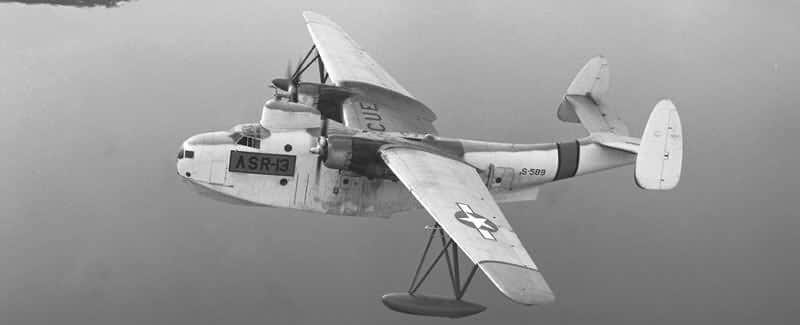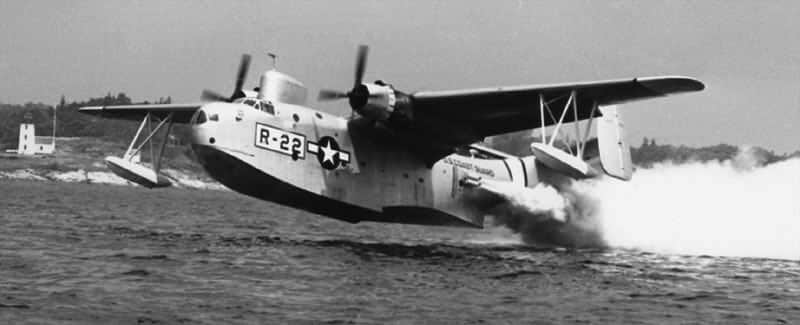
The Glenn L Martin Company began work on an improved military flying boat in 1937. Martin developed the “Model 162”. On 30 June 1937, the Navy awarded Martin a contract to build a prototype with the naval designation of “Experimental Patrol Bomber Martin 1 (XPBM-1)”. The Model 162 featured a deep hull and shoulder-mounted gull wings, with a flat twin-fin tail assembly, and wing floats that retracted inward. The gull wing kept the engines out of the ocean spray without use of a drag inducing parasol wing mount. The aircraft was to be powered by twin 1,600 HP Wright R-2600-6 Cyclone engines. The XPBM-1 prototype first flew on 18 February 1939 and deliveries of 21 PBM-1s began in October 1940. The type was given the name “Mariner”, in keeping with Martin’s custom of giving their aircraft names starting with “M”. A single PBM-1 was converted as a prototype of a long-range variant of the Mariner, designated the “XPBM-2” and used for development purposes.
The Navy’s experience with the PBM-1 was satisfactory enough to order 379 improved model designated PBM-3s in the fall of 1940, with the ultimate quantity being about twice that number. The initial PBM-3 was similar to the PBM-1 in most respects, differing mainly in the addition of upgraded Wright R-2600-12 Cyclones rated at 1700 hp each; a four bladed propeller; larger fixed wing floats; and revised engine nacelles that featured much bigger bombbays. A number of variants PBM-3 C/D/R/and S were produced. The variants primarily addressed differences in armaments and improvements in engine power.
Inadequate engine power remained a problem and a PBM-4 series that was to be powered by Wright R-3350-8 Cyclones rated at 2700HP each was considered. Orders were placed but the availability of the R-3350 engine became an issue and the PBM-4 orders were canceled. When a more powerful P&W R-2800-34 Twin Wasps, 2,100 HP engines became sufficiently available the Navy went to the PBM-5. The engines were fitted in revised and lengthened cowlings and drove four-bladed Curtiss props. The PBM-5 was fitted out for “jet assisted take-off” (JATO). The configuration of the PBM-5 was otherwise similar to that of the PBM-3D, with the same defensive armament, armor, self-sealing fuel tanks, and AN/APS-15 radar. Deliveries began in August 1944, with 589 delivered before the end of the war and the abrupt termination of production. The very last Mariner model to be produced was the PBM-5A, which was a PBM-5 fitted with tricycle landing gear for amphibious operation. The nose gear had twin wheels and retracted backward, while the main gear had single wheels and rotated up into the sides of the fuselage.

The Coast Guard acquired 27 Martin PBM-3 during the first half of 1943. In late 1944, the service acquired the first group of 41 PBM-5 models and the additional PBM-5s were delivered in the last half of 1945. The last of the PBM-3s were retired from service July 1, 1946. By May of 1947 there were only 24 PBM-5s still in service. The last ten were still in service in 1955 although all were gone from the inventory by 1956. These flying boats became the backbone of the long-range aerial search and rescue efforts of the Coast Guard in the early post-war years.
| Manufacturer | Glenn L. Martin | Cruise Speed | 170 mph |
|---|---|---|---|
| Designation | PBM-5 | Initial Climb | 410 fpm |
| Type | Flying-boat | Fuel Capacity | 3,488 gal |
| Wing Span | 118 ft | Range | 3,400 statute miles |
| Length | 80 ft | Service Ceiling | 17,000 |
| Height | 27 ft 6 in | Engines | P&W R2800-34 Radial |
| Empty Weight | 32,378 lb | 2100 HP | |
| Gross Weight | 58,000 ;b | Propellers | Curtiss |

